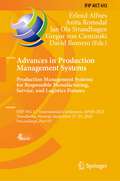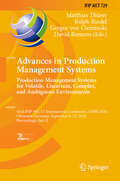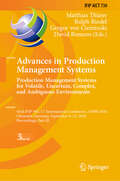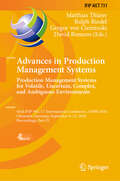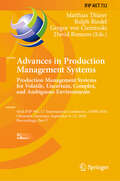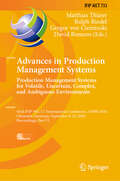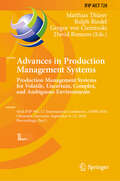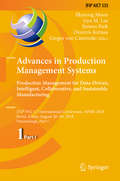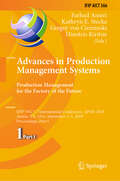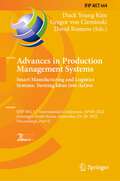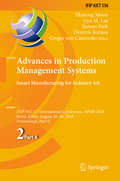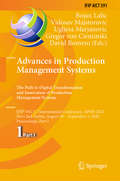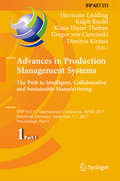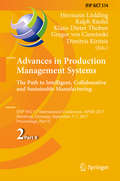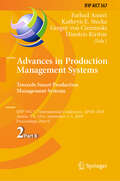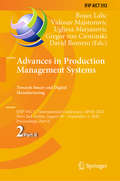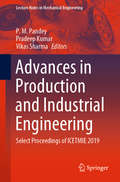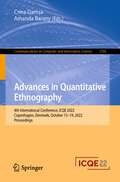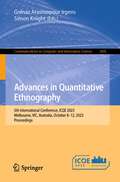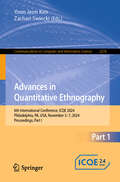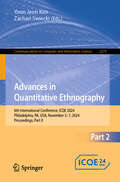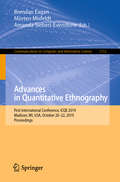- Table View
- List View
Advances in Production Management Systems. Production Management Systems for Responsible Manufacturing, Service, and Logistics Futures: IFIP WG 5.7 International Conference, APMS 2023, Trondheim, Norway, September 17–21, 2023, Proceedings, Part III (IFIP Advances in Information and Communication Technology #691)
by Gregor Von Cieminski Jan Ola Strandhagen David Romero Erlend Alfnes Anita RomsdalThis 4-volume set, IFIP AICT 689-692, constitutes the refereed proceedings of the International IFIP WG 5.7 Conference on Advances in Production Management Systems, APMS 2023, held in Trondheim, Norway, during September 17–21, 2023. The 213 full papers presented in these volumes were carefully reviewed and selected from a total of 224 submissions. They were organized in topical sections as follows: Part I : Lean Management in the Industry 4.0 Era; Crossroads and Paradoxes in the Digital Lean Manufacturing World; Digital Transformation Approaches in Production Management; Managing Digitalization of Production Systems; Workforce Evolutionary Pathways in Smart Manufacturing Systems; Next Generation Human-Centered Manufacturing and Logistics Systems for the Operator 5.0; and SME 5.0: Exploring Pathways to the Next Level of Intelligent, Sustainable, and Human-Centered SMEs. Part II : Digitally Enabled and Sustainable Service and Operations Management in PSS Lifecycle; Exploring Digital Servitization in Manufacturing; Everything-as-a-Service (XaaS) Business Models in the Manufacturing Industry; Digital Twin Concepts in Production and Services; Experiential Learning in Engineering Education; Lean in Healthcare; Additive Manufacturing in Operations and Supply Chain Management; and Applications of Artificial Intelligence in Manufacturing. Part III : Towards Next-Generation Production and SCM in Yard and Construction Industries; Transforming Engineer-to-Order Projects, Supply Chains and Ecosystems; Modelling Supply Chain and Production Systems; Advances in Dynamic Scheduling Technologies for Smart Manufacturing; and Smart Production Planning and Control. Part IV : Circular Manufacturing and Industrial Eco-Efficiency; Smart Manufacturing to Support Circular Economy; Product Information Management and Extended Producer Responsibility; Product and Asset Life Cycle Management for Sustainable and Resilient Manufacturing Systems; Sustainable Mass Customization in the Era of Industry 5.0; Food and Bio-Manufacturing; Battery Production Development and Management; Operations and SCM in Energy-Intensive Production for a Sustainable Future; and Resilience Management in Supply Chains.
Advances in Production Management Systems. Production Management Systems for Responsible Manufacturing, Service, and Logistics Futures: IFIP WG 5.7 International Conference, APMS 2023, Trondheim, Norway, September 17–21, 2023, Proceedings, Part IV (IFIP Advances in Information and Communication Technology #692)
by Gregor Von Cieminski Jan Ola Strandhagen David Romero Erlend Alfnes Anita RomsdalThis 4-volume set, IFIP AICT 689-692, constitutes the refereed proceedings of the International IFIP WG 5.7 Conference on Advances in Production Management Systems, APMS 2023, held in Trondheim, Norway, during September 17–21, 2023. The 213 full papers presented in these volumes were carefully reviewed and selected from a total of 224 submissions. They were organized in topical sections as follows: Part I : Lean Management in the Industry 4.0 Era; Crossroads and Paradoxes in the Digital Lean Manufacturing World; Digital Transformation Approaches in Production Management; Managing Digitalization of Production Systems; Workforce Evolutionary Pathways in Smart Manufacturing Systems; Next Generation Human-Centered Manufacturing and Logistics Systems for the Operator 5.0; and SME 5.0: Exploring Pathways to the Next Level of Intelligent, Sustainable, and Human-Centered SMEs. Part II : Digitally Enabled and Sustainable Service and Operations Management in PSS Lifecycle; Exploring Digital Servitization in Manufacturing; Everything-as-a-Service (XaaS) Business Models in the Manufacturing Industry; Digital Twin Concepts in Production and Services; Experiential Learning in Engineering Education; Lean in Healthcare; Additive Manufacturing in Operations and Supply Chain Management; and Applications of Artificial Intelligence in Manufacturing. Part III : Towards Next-Generation Production and SCM in Yard and Construction Industries; Transforming Engineer-to-Order Projects, Supply Chains and Ecosystems; Modelling Supply Chain and Production Systems; Advances in Dynamic Scheduling Technologies for Smart Manufacturing; and Smart Production Planning and Control. Part IV : Circular Manufacturing and Industrial Eco-Efficiency; Smart Manufacturing to Support Circular Economy; Product Information Management and Extended Producer Responsibility; Product and Asset Life Cycle Management for Sustainable and Resilient Manufacturing Systems; Sustainable Mass Customization in the Era of Industry 5.0; Food and Bio-Manufacturing; Battery Production Development and Management; Operations and SCM in Energy-Intensive Production for a Sustainable Future; and Resilience Management in Supply Chains.
Advances in Production Management Systems. Production Management Systems for Volatile, Uncertain, Complex, and Ambiguous Environments: 43rd IFIP WG 5.7 International Conference, APMS 2024, Chemnitz, Germany, September 8-12, 2024, Proceedings, Part II (IFIP Advances in Information and Communication Technology #729)
by Gregor Von Cieminski Matthias Thürer Ralph Riedel David RomeroThe six-volume set IFIP AICT 728-729 constitutes the refereed proceedings of the 43rd IFIP WG 5.7 International Conference on Advances in Production Management Systems, APMS 2024, held in Chemnitz, Germany, during September 8–12, 2024. The 201 full papers presented together were carefully reviewed and selected from 224 submissions. The APMS 2024 conference proceedings are organized into six volumes, covering a large spectrum of research addressing the overall topic of the conference “Production Management Systems for Volatile, Uncertain, Complex, and Ambiguous Environments”. Part I: advancing eco-efficient and circular industrial practices; barriers and challenges for transition towards circular and sustainable production processes and servitized business models; implementing the EU green deal: challenges and solutions for a sustainable supply chain; risk analysis and sustainability in an uncertain system in a digital era. Part II: smart and sustainable supply chain management in the society 5.0 era; human-centred manufacturing and logistics systems design and management for the operator 5.0; inclusive work systems design: applying technology to accommodate individual workers’ needs; evolving workforce skills and competencies for industry 5.0; experiential learning in engineering education. Part III: lean thinking models for operational excellence and sustainability in the industry 4.0 era; human in command – operator 4.0/5.0 in the age of AI and robotic systems; hybrid intelligence – decision-making for AI-enabled industry 5.0; mechanism design for smart and sustainable supply chains. Part IV: digital transformation approaches in production and management; new horizons for intelligent manufacturing systems with IoT, AI, and digital twins. Part V: smart manufacturing assets as drivers for the twin transition towards green and digital business; engineering and managing AI for advances in asset lifecycle and maintenance management; transforming engineer-to-Order projects, supply chains, and systems in turbulent times; methods and tools to achieve the digital and sustainable servitization of manufacturing companies; open knowledge networks for smart manufacturing; applications of artificial intelligence in manufacturing; intralogistics. Part VI: modelling supply chain and production systems; resilience management in supply chains; digital twin concepts in production and services; optimization; additive manufacturing; advances in production management systems.
Advances in Production Management Systems. Production Management Systems for Volatile, Uncertain, Complex, and Ambiguous Environments: 43rd IFIP WG 5.7 International Conference, APMS 2024, Chemnitz, Germany, September 8-12, 2024, Proceedings, Part III (IFIP Advances in Information and Communication Technology #730)
by Gregor Von Cieminski Matthias Thürer Ralph Riedel David RomeroThe six-volume set IFIP AICT 728-729 constitutes the refereed proceedings of the 43rd IFIP WG 5.7 International Conference on Advances in Production Management Systems, APMS 2024, held in Chemnitz, Germany, during September 8–12, 2024. The 201 full papers presented together were carefully reviewed and selected from 224 submissions. The APMS 2024 conference proceedings are organized into six volumes, covering a large spectrum of research addressing the overall topic of the conference “Production Management Systems for Volatile, Uncertain, Complex, and Ambiguous Environments”. Part I: advancing eco-efficient and circular industrial practices; barriers and challenges for transition towards circular and sustainable production processes and servitized business models; implementing the EU green deal: challenges and solutions for a sustainable supply chain; risk analysis and sustainability in an uncertain system in a digital era. Part II: smart and sustainable supply chain management in the society 5.0 era; human-centred manufacturing and logistics systems design and management for the operator 5.0; inclusive work systems design: applying technology to accommodate individual workers’ needs; evolving workforce skills and competencies for industry 5.0; experiential learning in engineering education. Part III: lean thinking models for operational excellence and sustainability in the industry 4.0 era; human in command – operator 4.0/5.0 in the age of AI and robotic systems; hybrid intelligence – decision-making for AI-enabled industry 5.0; mechanism design for smart and sustainable supply chains. Part IV: digital transformation approaches in production and management; new horizons for intelligent manufacturing systems with IoT, AI, and digital twins. Part V: smart manufacturing assets as drivers for the twin transition towards green and digital business; engineering and managing AI for advances in asset lifecycle and maintenance management; transforming engineer-to-Order projects, supply chains, and systems in turbulent times; methods and tools to achieve the digital and sustainable servitization of manufacturing companies; open knowledge networks for smart manufacturing; applications of artificial intelligence in manufacturing; intralogistics. Part VI: modelling supply chain and production systems; resilience management in supply chains; digital twin concepts in production and services; optimization; additive manufacturing; advances in production management systems.
Advances in Production Management Systems. Production Management Systems for Volatile, Uncertain, Complex, and Ambiguous Environments: 43rd IFIP WG 5.7 International Conference, APMS 2024, Chemnitz, Germany, September 8-12, 2024, Proceedings, Part IV (IFIP Advances in Information and Communication Technology #731)
by Gregor Von Cieminski Matthias Thürer Ralph Riedel David RomeroThe six-volume set IFIP AICT 728-729 constitutes the refereed proceedings of the 43rd IFIP WG 5.7 International Conference on Advances in Production Management Systems, APMS 2024, held in Chemnitz, Germany, during September 8–12, 2024. The 201 full papers presented together were carefully reviewed and selected from 224 submissions. The APMS 2024 conference proceedings are organized into six volumes, covering a large spectrum of research addressing the overall topic of the conference “Production Management Systems for Volatile, Uncertain, Complex, and Ambiguous Environments”. Part I: advancing eco-efficient and circular industrial practices; barriers and challenges for transition towards circular and sustainable production processes and servitized business models; implementing the EU green deal: challenges and solutions for a sustainable supply chain; risk analysis and sustainability in an uncertain system in a digital era. Part II: smart and sustainable supply chain management in the society 5.0 era; human-centred manufacturing and logistics systems design and management for the operator 5.0; inclusive work systems design: applying technology to accommodate individual workers’ needs; evolving workforce skills and competencies for industry 5.0; experiential learning in engineering education. Part III: lean thinking models for operational excellence and sustainability in the industry 4.0 era; human in command – operator 4.0/5.0 in the age of AI and robotic systems; hybrid intelligence – decision-making for AI-enabled industry 5.0; mechanism design for smart and sustainable supply chains. Part IV: digital transformation approaches in production and management; new horizons for intelligent manufacturing systems with IoT, AI, and digital twins. Part V: smart manufacturing assets as drivers for the twin transition towards green and digital business; engineering and managing AI for advances in asset lifecycle and maintenance management; transforming engineer-to-Order projects, supply chains, and systems in turbulent times; methods and tools to achieve the digital and sustainable servitization of manufacturing companies; open knowledge networks for smart manufacturing; applications of artificial intelligence in manufacturing; intralogistics. Part VI: modelling supply chain and production systems; resilience management in supply chains; digital twin concepts in production and services; optimization; additive manufacturing; advances in production management systems.
Advances in Production Management Systems. Production Management Systems for Volatile, Uncertain, Complex, and Ambiguous Environments: 43rd IFIP WG 5.7 International Conference, APMS 2024, Chemnitz, Germany, September 8-12, 2024, Proceedings, Part V (IFIP Advances in Information and Communication Technology #732)
by Gregor Von Cieminski Matthias Thürer Ralph Riedel David RomeroThe six-volume set IFIP AICT 728-729 constitutes the refereed proceedings of the 43rd IFIP WG 5.7 International Conference on Advances in Production Management Systems, APMS 2024, held in Chemnitz, Germany, during September 8–12, 2024. The 201 full papers presented together were carefully reviewed and selected from 224 submissions. The APMS 2024 conference proceedings are organized into six volumes, covering a large spectrum of research addressing the overall topic of the conference “Production Management Systems for Volatile, Uncertain, Complex, and Ambiguous Environments”. Part I: advancing eco-efficient and circular industrial practices; barriers and challenges for transition towards circular and sustainable production processes and servitized business models; implementing the EU green deal: challenges and solutions for a sustainable supply chain; risk analysis and sustainability in an uncertain system in a digital era. Part II: smart and sustainable supply chain management in the society 5.0 era; human-centred manufacturing and logistics systems design and management for the operator 5.0; inclusive work systems design: applying technology to accommodate individual workers’ needs; evolving workforce skills and competencies for industry 5.0; experiential learning in engineering education. Part III: lean thinking models for operational excellence and sustainability in the industry 4.0 era; human in command – operator 4.0/5.0 in the age of AI and robotic systems; hybrid intelligence – decision-making for AI-enabled industry 5.0; mechanism design for smart and sustainable supply chains. Part IV: digital transformation approaches in production and management; new horizons for intelligent manufacturing systems with IoT, AI, and digital twins. Part V: smart manufacturing assets as drivers for the twin transition towards green and digital business; engineering and managing AI for advances in asset lifecycle and maintenance management; transforming engineer-to-Order projects, supply chains, and systems in turbulent times; methods and tools to achieve the digital and sustainable servitization of manufacturing companies; open knowledge networks for smart manufacturing; applications of artificial intelligence in manufacturing; intralogistics. Part VI: modelling supply chain and production systems; resilience management in supply chains; digital twin concepts in production and services; optimization; additive manufacturing; advances in production management systems.
Advances in Production Management Systems. Production Management Systems for Volatile, Uncertain, Complex, and Ambiguous Environments: 43rd IFIP WG 5.7 International Conference, APMS 2024, Chemnitz, Germany, September 8-12, 2024, Proceedings, Part VI (IFIP Advances in Information and Communication Technology #733)
by Gregor Von Cieminski Matthias Thürer Ralph Riedel David RomeroThe six-volume set IFIP AICT 728-729 constitutes the refereed proceedings of the 43rd IFIP WG 5.7 International Conference on Advances in Production Management Systems, APMS 2024, held in Chemnitz, Germany, during September 8–12, 2024. The 201 full papers presented together were carefully reviewed and selected from 224 submissions. The APMS 2024 conference proceedings are organized into six volumes, covering a large spectrum of research addressing the overall topic of the conference “Production Management Systems for Volatile, Uncertain, Complex, and Ambiguous Environments”. Part I: advancing eco-efficient and circular industrial practices; barriers and challenges for transition towards circular and sustainable production processes and servitized business models; implementing the EU green deal: challenges and solutions for a sustainable supply chain; risk analysis and sustainability in an uncertain system in a digital era. Part II: smart and sustainable supply chain management in the society 5.0 era; human-centred manufacturing and logistics systems design and management for the operator 5.0; inclusive work systems design: applying technology to accommodate individual workers’ needs; evolving workforce skills and competencies for industry 5.0; experiential learning in engineering education. Part III: lean thinking models for operational excellence and sustainability in the industry 4.0 era; human in command – operator 4.0/5.0 in the age of AI and robotic systems; hybrid intelligence – decision-making for AI-enabled industry 5.0; mechanism design for smart and sustainable supply chains. Part IV: digital transformation approaches in production and management; new horizons for intelligent manufacturing systems with IoT, AI, and digital twins. Part V: smart manufacturing assets as drivers for the twin transition towards green and digital business; engineering and managing AI for advances in asset lifecycle and maintenance management; transforming engineer-to-Order projects, supply chains, and systems in turbulent times; methods and tools to achieve the digital and sustainable servitization of manufacturing companies; open knowledge networks for smart manufacturing; applications of artificial intelligence in manufacturing; intralogistics. Part VI: modelling supply chain and production systems; resilience management in supply chains; digital twin concepts in production and services; optimization; additive manufacturing; advances in production management systems.
Advances in Production Management Systems. Production Management Systems for Volatile, Uncertain, Complex, and Ambiguous Environments: 43rd IFIP WG 5.7 International Conference, APMS 2024, Chemnitz, Germany, September 8–12, 2024, Proceedings, Part I (IFIP Advances in Information and Communication Technology #728)
by Gregor Von Cieminski Matthias Thürer Ralph Riedel David RomeroThe six-volume set IFIP AICT 728-729 constitutes the refereed proceedings of the 43rd IFIP WG 5.7 International Conference on Advances in Production Management Systems, APMS 2024, held in Chemnitz, Germany, during September 8–12, 2024. The 201 full papers presented together were carefully reviewed and selected from 224 submissions. The APMS 2024 conference proceedings are organized into six volumes, covering a large spectrum of research addressing the overall topic of the conference “Production Management Systems for Volatile, Uncertain, Complex, and Ambiguous Environments”. Part I: advancing eco-efficient and circular industrial practices; barriers and challenges for transition towards circular and sustainable production processes and servitized business models; implementing the EU green deal: challenges and solutions for a sustainable supply chain; risk analysis and sustainability in an uncertain system in a digital era. Part II: smart and sustainable supply chain management in the society 5.0 era; human-centred manufacturing and logistics systems design and management for the operator 5.0; inclusive work systems design: applying technology to accommodate individual workers’ needs; evolving workforce skills and competencies for industry 5.0; experiential learning in engineering education. Part III: lean thinking models for operational excellence and sustainability in the industry 4.0 era; human in command – operator 4.0/5.0 in the age of AI and robotic systems; hybrid intelligence – decision-making for AI-enabled industry 5.0; mechanism design for smart and sustainable supply chains. Part IV: digital transformation approaches in production and management; new horizons for intelligent manufacturing systems with IoT, AI, and digital twins. Part V: smart manufacturing assets as drivers for the twin transition towards green and digital business; engineering and managing AI for advances in asset lifecycle and maintenance management; transforming engineer-to-Order projects, supply chains, and systems in turbulent times; methods and tools to achieve the digital and sustainable servitization of manufacturing companies; open knowledge networks for smart manufacturing; applications of artificial intelligence in manufacturing; intralogistics. Part VI: modelling supply chain and production systems; resilience management in supply chains; digital twin concepts in production and services; optimization; additive manufacturing; advances in production management systems.
Advances in Production Management Systems. Production Management for Data-Driven, Intelligent, Collaborative, and Sustainable Manufacturing: IFIP WG 5.7 International Conference, APMS 2018, Seoul, Korea, August 26-30, 2018, Proceedings, Part I (IFIP Advances in Information and Communication Technology #535)
by Dimitris Kiritsis Gregor Von Cieminski Ilkyeong Moon Gyu M. Lee Jinwoo ParkThe two-volume set IFIP AICT 535 and 536 constitutes the refereed proceedings of the International IFIP WG 5.7 Conference on Advances in Production Management Systems, APMS 2018, held in Seoul, South Korea, in August 2018.The 129 revised full papers presented were carefully reviewed and selected from 149 submissions. They are organized in the following topical sections: lean and green manufacturing; operations management in engineer-to-order manufacturing; product-service systems, customer-driven innovation and value co-creation; collaborative networks; smart production for mass customization; global supply chain management; knowledge based production planning and control; knowledge based engineering; intelligent diagnostics and maintenance solutions for smart manufacturing; service engineering based on smart manufacturing capabilities; smart city interoperability and cross-platform implementation; manufacturing performance management in smart factories; industry 4.0 - digital twin; industry 4.0 - smart factory; and industry 4.0 - collaborative cyber-physical production and human systems.
Advances in Production Management Systems. Production Management for the Factory of the Future: IFIP WG 5.7 International Conference, APMS 2019, Austin, TX, USA, September 1–5, 2019, Proceedings, Part I (IFIP Advances in Information and Communication Technology #566)
by Dimitris Kiritsis Gregor Von Cieminski Farhad Ameri Kathryn E. SteckeThe two-volume set IFIP AICT 566 and 567 constitutes the refereed proceedings of the International IFIP WG 5.7 Conference on Advances in Production Management Systems, APMS 2019, held in Austin, TX, USA.The 161 revised full papers presented were carefully reviewed and selected from 184 submissions. They discuss globally pressing issues in smart manufacturing, operations management, supply chain management, and Industry 4.0. The papers are organized in the following topical sections: lean production; production management in food supply chains; sustainability and reconfigurability of manufacturing systems; product and asset life cycle management in smart factories of industry 4.0; variety and complexity management in the era of industry 4.0; participatory methods for supporting the career choices in industrial engineering and management education; blockchain in supply chain management; designing and delivering smart services in the digital age; operations management in engineer-to-order manufacturing; the operator 4.0 and the Internet of Things, services and people; intelligent diagnostics and maintenance solutions for smart manufacturing; smart supply networks; production management theory and methodology; data-driven production management; industry 4.0 implementations; smart factory and IIOT; cyber-physical systems; knowledge management in design and manufacturing; collaborative product development; ICT for collaborative manufacturing; collaborative technoloy; applications of machine learning in production management; and collaborative technology.
Advances in Production Management Systems. Smart Manufacturing and Logistics Systems: IFIP WG 5.7 International Conference, APMS 2022, Gyeongju, South Korea, September 25–29, 2022, Proceedings, Part I (IFIP Advances in Information and Communication Technology #663)
by Gregor Von Cieminski David Romero Duck Young KimThis two-volume set, IFIP AICT 663 and 664, constitutes the thoroughly refereed proceedings of the International IFIP WG 5.7 Conference on Advances in Production Management Systems, APMS 2022, held in Gyeongju, South Korea in September 2022.The 139 full papers presented in these volumes were carefully reviewed and selected from a total of 153 submissions. The papers of APMS 2022 are organized into two parts. The topics of special interest in the first part included: AI & Data-driven Production Management; Smart Manufacturing & Industry 4.0; Simulation & Model-driven Production Management; Service Systems Design, Engineering & Management; Industrial Digital Transformation; Sustainable Production Management; and Digital Supply Networks. The second part included the following subjects: Development of Circular Business Solutions and Product-Service Systems through Digital Twins; “Farm-to-Fork” Production Management in Food Supply Chains; Urban Mobility and City Logistics; Digital Transformation Approaches in Production Management; Smart Supply Chain and Production in Society 5.0 Era; Service and Operations Management in the Context of Digitally-enabled Product-Service Systems; Sustainable and Digital Servitization; Manufacturing Models and Practices for Eco-Efficient, Circular and Regenerative Industrial Systems; Cognitive and Autonomous AI in Manufacturing and Supply Chains; Operators 4.0 and Human-Technology Integration in Smart Manufacturing and Logistics Environments; Cyber-Physical Systems for Smart Assembly and Logistics in Automotive Industry; and Trends, Challenges and Applications of Digital Lean Paradigm.
Advances in Production Management Systems. Smart Manufacturing and Logistics Systems: IFIP WG 5.7 International Conference, APMS 2022, Gyeongju, South Korea, September 25–29, 2022, Proceedings, Part II (IFIP Advances in Information and Communication Technology #664)
by Gregor Von Cieminski David Romero Duck Young KimThis two-volume set, IFIP AICT 663 and 664, constitutes the thoroughly refereed proceedings of the International IFIP WG 5.7 Conference on Advances in Production Management Systems, APMS 2022, held in Gyeongju, South Korea in September 2022.The 139 full papers presented in these volumes were carefully reviewed and selected from a total of 153 submissions. The papers of APMS 2022 are organized into two parts. The topics of special interest in the first part included: AI & Data-driven Production Management; Smart Manufacturing & Industry 4.0; Simulation & Model-driven Production Management; Service Systems Design, Engineering & Management; Industrial Digital Transformation; Sustainable Production Management; and Digital Supply Networks. The second part included the following subjects: Development of Circular Business Solutions and Product-Service Systems through Digital Twins; “Farm-to-Fork” Production Management in Food Supply Chains; Urban Mobility and City Logistics; Digital Transformation Approaches in Production Management; Smart Supply Chain and Production in Society 5.0 Era; Service and Operations Management in the Context of Digitally-enabled Product-Service Systems; Sustainable and Digital Servitization; Manufacturing Models and Practices for Eco-Efficient, Circular and Regenerative Industrial Systems; Cognitive and Autonomous AI in Manufacturing and Supply Chains; Operators 4.0 and Human-Technology Integration in Smart Manufacturing and Logistics Environments; Cyber-Physical Systems for Smart Assembly and Logistics in Automotive Industry; and Trends, Challenges and Applications of Digital Lean Paradigm.
Advances in Production Management Systems. Smart Manufacturing for Industry 4.0: IFIP WG 5.7 International Conference, APMS 2018, Seoul, Korea, August 26-30, 2018, Proceedings, Part II (IFIP Advances in Information and Communication Technology #536)
by Dimitris Kiritsis Gregor Von Cieminski Ilkyeong Moon Gyu M. Lee Jinwoo ParkThe two-volume set IFIP AICT 535 and 536 constitutes the refereed proceedings of the International IFIP WG 5.7 Conference on Advances in Production Management Systems, APMS 2018, held in Seoul, South Korea, in August 2018.The 129 revised full papers presented were carefully reviewed and selected from 149 submissions. They are organized in the following topical sections: lean and green manufacturing; operations management in engineer-to-order manufacturing; product-service systems, customer-driven innovation and value co-creation; collaborative networks; smart production for mass customization; global supply chain management; knowledge based production planning and control; knowledge based engineering; intelligent diagnostics and maintenance solutions for smart manufacturing; service engineering based on smart manufacturing capabilities; smart city interoperability and cross-platform implementation; manufacturing performance management in smart factories; industry 4.0 - digital twin; industry 4.0 - smart factory; and industry 4.0 - collaborative cyber-physical production and human systems.
Advances in Production Management Systems. The Path to Digital Transformation and Innovation of Production Management Systems: IFIP WG 5.7 International Conference, APMS 2020, Novi Sad, Serbia, August 30 – September 3, 2020, Proceedings, Part I (IFIP Advances in Information and Communication Technology #591)
by Gregor Von Cieminski Vidosav Majstorovic David Romero Bojan Lalic Ugljesa MarjanovicThe two-volume set IFIP AICT 591 and 592 constitutes the refereed proceedings of the International IFIP WG 5.7 Conference on Advances in Production Management Systems, APMS 2020, held in Novi Sad, Serbia, in August/September 2020.The 164 papers presented were carefully reviewed and selected from 199 submissions. They discuss globally pressing issues in smart manufacturing, operations management, supply chain management, and Industry 4.0. The papers are organized in the following topical sections: Part I: advanced modelling, simulation and data analytics in production and supply networks; advanced, digital and smart manufacturing; digital and virtual quality management systems; cloud-manufacturing; cyber-physical production systems and digital twins; IIOT interoperability; supply chain planning and optimization; digital and smart supply chain management; intelligent logistics networks management; artificial intelligence and blockchain technologies in logistics and DSN; novel production planning and control approaches; machine learning and artificial intelligence; connected, smart factories of the future; manufacturing systems engineering: agile, flexible, reconfigurable; digital assistance systems: augmented reality and virtual reality; circular products design and engineering; circular, green, sustainable manufacturing; environmental and social lifecycle assessments; socio-cultural aspects in production systems; data-driven manufacturing and services operations management; product-service systems in DSN; and collaborative design and engineering Part II: the Operator 4.0: new physical and cognitive evolutionary paths; digital transformation approaches in production management; digital transformation for more sustainable supply chains; data-driven applications in smart manufacturing and logistics systems; data-driven services: characteristics, trends and applications; the future of lean thinking and practice; digital lean manufacturing and its emerging practices; new reconfigurable, flexible or agile production systems in the era of industry 4.0; operations management in engineer-to-order manufacturing; production management in food supply chains; gastronomic service system design; product and asset life cycle management in the circular economy; and production ramp-up strategies for product
Advances in Production Management Systems. The Path to Intelligent, Collaborative and Sustainable Manufacturing: IFIP WG 5.7 International Conference, APMS 2017, Hamburg, Germany, September 3-7, 2017, Proceedings, Part I (IFIP Advances in Information and Communication Technology #513)
by Hermann Lödding Klaus-Dieter Thoben Dimitris Kiritsis Gregor Von Cieminski Ralph RiedelThe two-volume set IFIP AICT 513 and 514 constitutes the refereed proceedings of the International IFIP WG 5. 7 Conference on Advances in Production Management Systems, APMS 2017, held in Hamburg, Germany, in September 2017. The 121 revised full papers presented were carefully reviewed and selected from 163 submissions. They are organized in the following topical sections: smart manufacturing system characterization; product and asset life cycle management in smart factories of industry 4. 0; cyber-physical (IIoT) technology deployments in smart manufacturing systems; multi-disciplinary collaboration in the development of smart product-service solutions; sustainable human integration in cyber-physical systems: the operator 4. 0; intelligent diagnostics and maintenance solutions; operations planning, scheduling and control; supply chain design; production management in food supply chains; factory planning; industrial and other services; operations management in engineer-to-order manufacturing; gamification of complex systems design development; lean and green manufacturing; and eco-efficiency in manufacturing operations.
Advances in Production Management Systems. The Path to Intelligent, Collaborative and Sustainable Manufacturing: IFIP WG 5.7 International Conference, APMS 2017, Hamburg, Germany, September 3-7, 2017, Proceedings, Part II (IFIP Advances in Information and Communication Technology #514)
by Hermann Lödding Klaus-Dieter Thoben Dimitris Kiritsis Gregor Von Cieminski Ralph RiedelThe two-volume set IFIP AICT 513 and 514 constitutes the refereed proceedings of the International IFIP WG 5. 7 Conference on Advances in Production Management Systems, APMS 2017, held in Hamburg, Germany, in September 2017. The 121 revised full papers presented were carefully reviewed and selected from 163 submissions. They are organized in the following topical sections: smart manufacturing system characterization; product and asset life cycle management in smart factories of industry 4. 0; cyber-physical (IIoT) technology deployments in smart manufacturing systems; multi-disciplinary collaboration in the development of smart product-service solutions; sustainable human integration in cyber-physical systems: the operator 4. 0; intelligent diagnostics and maintenance solutions; operations planning, scheduling and control; supply chain design; production management in food supply chains; factory planning; industrial and other services; operations management in engineer-to-order manufacturing; gamification of complex systems design development; lean and green manufacturing; and eco-efficiency in manufacturing operations.
Advances in Production Management Systems. Towards Smart Production Management Systems: IFIP WG 5.7 International Conference, APMS 2019, Austin, TX, USA, September 1–5, 2019, Proceedings, Part II (IFIP Advances in Information and Communication Technology #567)
by Dimitris Kiritsis Gregor Von Cieminski Farhad Ameri Kathryn E. SteckeThe two-volume set IFIP AICT 566 and 567 constitutes the refereed proceedings of the International IFIP WG 5.7 Conference on Advances in Production Management Systems, APMS 2019, held in Austin, TX, USA.The 161 revised full papers presented were carefully reviewed and selected from 184 submissions. They discuss globally pressing issues in smart manufacturing, operations management, supply chain management, and Industry 4.0. The papers are organized in the following topical sections: lean production; production management in food supply chains; sustainability and reconfigurability of manufacturing systems; product and asset life cycle management in smart factories of industry 4.0; variety and complexity management in the era of industry 4.0; participatory methods for supporting the career choices in industrial engineering and management education; blockchain in supply chain management; designing and delivering smart services in the digital age; operations management in engineer-to-order manufacturing; the operator 4.0 and the Internet of Things, services and people; intelligent diagnostics and maintenance solutions for smart manufacturing; smart supply networks; production management theory and methodology; data-driven production management; industry 4.0 implementations; smart factory and IIOT; cyber-physical systems; knowledge management in design and manufacturing; collaborative product development; ICT for collaborative manufacturing; collaborative technoloy; applications of machine learning in production management; and collaborative technology.
Advances in Production Management Systems. Towards Smart and Digital Manufacturing: IFIP WG 5.7 International Conference, APMS 2020, Novi Sad, Serbia, August 30 – September 3, 2020, Proceedings, Part II (IFIP Advances in Information and Communication Technology #592)
by Gregor Von Cieminski Vidosav Majstorovic David Romero Bojan Lalic Ugljesa MarjanovicThe two-volume set IFIP AICT 591 and 592 constitutes the refereed proceedings of the International IFIP WG 5.7 Conference on Advances in Production Management Systems, APMS 2020, held in Novi Sad, Serbia, in August/September 2020. The 164 papers presented were carefully reviewed and selected from 199 submissions. They discuss globally pressing issues in smart manufacturing, operations management, supply chain management, and Industry 4.0. The papers are organized in the following topical sections: Part I: advanced modelling, simulation and data analytics in production and supply networks; advanced, digital and smart manufacturing; digital and virtual quality management systems; cloud-manufacturing; cyber-physical production systems and digital twins; IIOT interoperability; supply chain planning and optimization; digital and smart supply chain management; intelligent logistics networks management; artificial intelligence and blockchain technologies in logistics and DSN; novel production planning and control approaches; machine learning and artificial intelligence; connected, smart factories of the future; manufacturing systems engineering: agile, flexible, reconfigurable; digital assistance systems: augmented reality and virtual reality; circular products design and engineering; circular, green, sustainable manufacturing; environmental and social lifecycle assessments; socio-cultural aspects in production systems; data-driven manufacturing and services operations management; product-service systems in DSN; and collaborative design and engineering Part II: the Operator 4.0: new physical and cognitive evolutionary paths; digital transformation approaches in production management; digital transformation for more sustainable supply chains; data-driven applications in smart manufacturing and logistics systems; data-driven services: characteristics, trends and applications; the future of lean thinking and practice; digital lean manufacturing and its emerging practices; new reconfigurable, flexible or agile production systems in the era of industry 4.0; operations management in engineer-to-order manufacturing; production management in food supply chains; gastronomic service system design; product and asset life cycle management in the circular economy; and production ramp-up strategies for product
Advances in Production and Industrial Engineering: Select Proceedings of ICETMIE 2019 (Lecture Notes in Mechanical Engineering)
by Pradeep Kumar Vikas Sharma P. M. PandeyThis book comprises the select proceedings of the International Conference on Emerging Trends in Mechanical and Industrial Engineering (ICETMIE) 2019. The conference covers current trends in thermal, design, industrial, production and other sub-disciplines of mechanical engineering. This volume focuses on different industrial and production engineering areas such as additive manufacturing, rapid prototyping, computer aided engineering, advanced manufacturing processes, manufacturing management and automation, sustainable manufacturing systems, metrology, manufacturing process optimization, operations research and decision-making models, production planning and inventory control, supply chain management, and quality engineering. The contents of this book will be useful for students, researchers and other professionals interested in industrial and production engineering.
Advances in Quantitative Ethnography: 4th International Conference, ICQE 2022, Copenhagen, Denmark, October 15–19, 2022, Proceedings (Communications in Computer and Information Science #1785)
by Crina Damşa Amanda BaranyThis book constitutes the refereed proceedings of the 4th International Conference on Advances in Quantitative Ethnography, ICQE 2022, held in Copenhagen, Denmark, during October 15–19, 2022.The 29 full papers included in this book were carefully reviewed and selected from 71 submissions. They were organized in topical sections as follows: QE Theory and Methodology Research; Applications in Education Contexts; and Applications in Interdisciplinary Contexts.
Advances in Quantitative Ethnography: 5th International Conference, ICQE 2023, Melbourne, VIC, Australia, October 8–12, 2023, Proceedings (Communications in Computer and Information Science #1895)
by Golnaz Arastoopour Irgens Simon KnightThis book constitutes the refereed proceedings of the 5th International Conference on Advances in Quantitative Ethnography, ICQE 2023, held in Melbourne, VIC, Australia, during October 8–12, 2023.The 33 full papers included in this book were carefully reviewed and selected from 39 submissions. They were organized in topical sections as follows: understanding learners and learning; society, culture, identity, and justice; and advances in QE methodologies.
Advances in Quantitative Ethnography: 6th International Conference, ICQE 2024, Philadelphia, PA, USA, November 3-7, 2024, Proceedings, Part I (Communications in Computer and Information Science #2278)
by Yoon Jeon Kim Zachari SwieckiThis two-volume set CCIS 2278-2279 constitutes the refereed proceedings of the 6th International Conference on Advances in Quantitative Ethnography, ICQE 2024, held in Philadelphia, PA, USA, during November 3-7, 2024. The 31 full papers and 10 short papers included in this book were carefully reviewed and selected from 82 submissions. They are organized in the following topical sections: Theory and Methods; Teaching and Learning; and Cultural Discourse.
Advances in Quantitative Ethnography: 6th International Conference, ICQE 2024, Philadelphia, PA, USA, November 3-7, 2024, Proceedings, Part II (Communications in Computer and Information Science #2279)
by Yoon Jeon Kim Zachari SwieckiThis two-volume set CCIS 2278-2279 constitutes the refereed proceedings of the 6th International Conference on Advances in Quantitative Ethnography, ICQE 2024, held in Philadelphia, PA, USA, during November 3-7, 2024. The 31 full papers and 10 short papers included in this book were carefully reviewed and selected from 82 submissions. They are organized in the following topical sections: Theory and Methods; Teaching and Learning; and Cultural Discourse.
Advances in Quantitative Ethnography: First International Conference, ICQE 2019, Madison, WI, USA, October 20–22, 2019, Proceedings (Communications in Computer and Information Science #1112)
by Brendan Eagan Morten Misfeldt Amanda Siebert-EvenstoneThis book constitutes the refereed proceedings of the First International Conference on Quantitative Ethnography, ICQE 2019, held in Madison, Wisconsin, USA, in October 2019. It consists of 23 full and 9 short carefully reviewed papers selected from 52 submissions. The contributions come from a diverse range of fields and perspectives, including learning analytics, history, and systems engineering, all attempting to understand the breadth of human behavior using quantitative ethnographic approaches.
Advances in Quantitative Ethnography: Second International Conference, ICQE 2020, Malibu, CA, USA, February 1-3, 2021, Proceedings (Communications in Computer and Information Science #1312)
by Andrew R. Ruis Seung B. LeeThis book constitutes the refereed proceedings of the Second International Conference on Quantitative Ethnography, ICQE 2020, held in February 2021. Due to the COVID-19 pandemic the conference has been postponed to 2021 and was held in online format. The 28 full papers were selected from 56 submissions. The contributions in this volume come from diverse fields and perspectives, and present the studies on advantages of using quantitative ethnography methods and techniques in a number of different domains and contexts, including ethnography and statistics, human interpretation and machine processing, etc.

